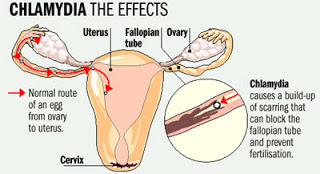WHY CHLAMYDIA IS THE MAJOR CAUSE OF INFERTILITY

Couples of years back; Gonorrhea was the leading cause of Infertility in both men and women.However, that has since change as a new sexually transmitted disease known as Chlamydia has emerged as the major cause of Infertility. Chlamydia is now one of the prevalent bacteria found in classic Sexually Transmissible Diseases (STD) and as such, constitutes a serious public health problem. Chlamydia trachomatis infections are known to manifest in a variety of syndromes in both men and women when left undiagnosed and untreated. While the clinical presentations in men include Urethritis, Epididymitis, etc., women suffer more serious complications such as Mucopurulent Cervicitis, Pelvic Inflammatory Disease (PID), Ectopic pregnancy and Tubal infertility. In this report, City People Fashion Editor BOLA AKINBOADE presents to you all you need to know about this killer disease.
ABOUT CHLAMYDIA
Chlamydia is a sexually transmitted disease (STD) caused by the bacteria Chlamydia trachomatis. The number of new diagnoses has been steadily increasing and it has become the most commonly diagnosed STD. Chlamydia is called the ‘silent’ disease because most people who get it do not experience any noticeable symptoms. Around 50% of men and 70-80% of women who get the Chlamydia infection will have no symptoms and many cases of Chlamydia remain undiagnosed When transmitted through sexual contact, the bacteria can infect the urinary and reproductive organs leading to infertility if not properly treated.
Even though symptoms of Chlamydia are usually mild or absent, serious complications that cause irreversible damage, including infertility, can occur “silently” before a woman ever recognizes a problem. Chlamydia also can cause discharge from the penis of an infected man.
It’s also important for them to take the precautions to prevent Chlamydia, and if it’s suspected, to seek treatment as soon as possible.
HOW DO PEOPLE GET CHLAMYDIA
Chlamydia can be transmitted during vaginal, anal, or oral sex. Chlamydia can also be passed from an infected mother to her baby during vaginal childbirth.
Any sexually active person can be infected with Chlamydia. The greater the number of sex partners, the greater the risk of infection. Because the cervix (opening to the uterus) of teenage girls and young women is not fully matured and is probably more susceptible to infection, they are at particularly high risk for infection if sexually active. Since Chlamydia can be transmitted by oral or anal sex, men who have sex with men are also at risk for Chlamydia infection.
SYMPTOMS
In many cases, Chlamydia causes only mild symptoms or no symptoms at all. So an infection can last for weeks or months before it is discovered.
Chlamydia is known as a “silent” disease because about three quarters of infected women and about half of infected men have no symptoms. If symptoms do occur, they usually appear within 1 to 3 weeks after exposure.
In women, the bacteria initially infect the cervix and the urethra (urine canal). Women who have symptoms might have an abnormal vaginal discharge or a burning sensation when urinating. When the infection spreads from the cervix to the fallopian tubes (tubes that carry fertilized eggs from the ovaries to the uterus), some women still have no signs or symptoms; others have lower abdominal pain, low back pain, nausea, fever, pain during intercourse, or bleeding between menstrual periods. Chlamydia infection of the cervix can spread to the rectum. If Chlamydia or PID infections go untreated in females, they can lead to scarring of the fallopian tubes, which can lead to other serious health problems such as Chronic Pelvic Pain, Infertility, or Ectopic (tubal) pregnancy.
Just like in females, Chlamydia may be completely without symptoms in males.
Men with signs or symptoms might have a discharge from their penis or a burning sensation when urinating. Men might also have burning and itching around the opening of the penis. Pain and swelling in the testicles are uncommon.
Men or women who have receptive anal intercourse may acquire Chlamydia infection in the rectum, which can cause rectal pain, discharge, or bleeding. Untreated infections can lead to Epididymitis, an inflammation of the coiled tubes in the back of the testicles. This can result in testicular swelling, pain, and even infertility.
Chlamydia can also be found in the throats of women and men having oral sex with an infected partner.
CONTAGIOUSNESS
Chlamydia is contagious. It can be transmitted through sexual contact, in semen and vaginal secretions.
Chlamydia does not spread through casual contact such as shaking hands or using the same toilet as someone who is infected. If someone is diagnosed with Chlamydia, all of that person’s sexual partners need to be notified and treated with antibiotics, even if they don’t have any symptoms, so that they don’t develop any long-term complications or spread the infection to others.
COMPLICATIONS THAT CAN RESULT FROM UNTREATED CHLAMYDIA
If untreated, Chlamydia infections can progress to serious reproductive and other health problems with both short-term and long-term consequences. Like the disease itself, the damage that Chlamydia causes is often not easily detected.
In women, untreated infection can spread into the uterus or fallopian tubes and cause Pelvic Inflammatory Disease (PID). This happens in up to 40 percent of women with untreated Chlamydia. PID can cause permanent damage to the fallopian tubes, uterus, and surrounding tissues. The damage can lead to chronic pelvic pain, infertility, and potential fatal ectopic pregnancy (pregnancy outside the uterus). Women infected with Chlamydia are up to five times more likely to become infected with HIV, if exposed.
Complications among men are rare. Infection sometimes spreads to the Epididymis (the tube that carries sperm from the testis), causing pain, fever, and, rarely, sterility.
Also, genital Chlamydia infection can cause arthritis that can be accompanied by skin lesions and inflammation of the eye and urethra (Reiter’s syndrome).
TREATMENT
If detected early, Chlamydia can easily be treated with antibiotics and the symptoms alleviated within 7 to 10 days. If untreated, Chlamydia can lead to serious complications that can appear months or even years after the person is infected.
There are medications currently available for effective treat of Chlamydia. However, once treated, a young person is encouraged to be screened for Chlamydia again about 3 months after treatment. This is because up to 20% of young women are re-exposed to Chlamydia and need to be treated again. The most common reason for exposure is a sexual partner who hasn’t been adequately treated.
The sexual partners of anyone who has or is suspected of having Chlamydia or any other STD should be examined and treated. Those diagnosed with any STD should inform their partners as soon as possible so that they can be examined and treated, in order to prevent complications, and avoid spreading the infections to others.
All sex partners should be evaluated, tested, and treated. Persons with Chlamydia should abstain from sexual intercourse until they and their sex partners have completed treatment, otherwise re-infection is possible.
Women whose sex partners have not been appropriately treated are at high risk for re-infection. Having multiple infections increases a woman’s risk of serious reproductive health complications, including infertility. Retesting should be encouraged for women three to four months after treatment. This is especially true if a woman does not know if her sex partner received treatment.
PREVENTION
Because Chlamydia is spread through sexual contact, the best way to prevent it is to abstain from having sex. Sexual contact with more than one partner or with someone who has more than one partner increases the risk of contracting any STD.
Once sexual activity is part of a young person’s life, it is important to be screened yearly for Chlamydia by a medical practioner. This is important whether or not symptoms of an infection are present.
In addition, when properly and consistently used, condoms decrease the risk of STDs, including Chlamydia.
Although birth control pills offer no protection against STDs, they may provide some protection against PID by causing the body to create thicker cervical mucus, making it more difficult for bacteria to reach the upper genital tract.
Using douche can actually increase a female’s risk of contracting STDs because it can change the natural flora of the vagina and may flush bacteria higher into the genital tract.
- HOW TO DRESS LIKE PARISIAN WOMEN: ACHIEVING EFFORTLESS CHIC - August 14, 2024
- THE BRAVE ADVENTURE OF JOSH THE GREAT: A FAITH-FILLED JOURNEY OF COURAGE AND FORGIVENESS - August 14, 2024
- FASHION AND BEAUTY ICONS FROM AROUND THE WORLD - July 28, 2024




When someone writes an article he/she retains the idea of a user in his/her mind that how a user can be aware of it.
Thus that's why this paragraph is outstdanding. Thanks!
my web page > hgh energizer
of course like your web-site but you need to take a look at the spelling on
several of your posts. Many of them are rife with
spelling problems and I find it very bothersome to inform the truth on the other hand I'll surely come back again.
My blog post : how to treat acne
Good info. Lucky me I came across your blog by accident (stumbleupon).
I've book marked it for later!
Also visit my site :: weight loss pills
I'm not sure where you are getting your info, but great topic. I needs to spend some time learning more or understanding more. Thanks for great information I was looking for this info for my mission.
Feel free to visit my web page phen375 south africa buy